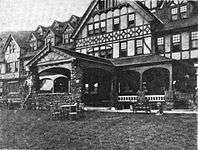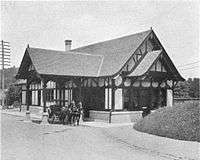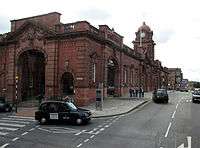Porte-cochère


A porte-cochère (/ˌpɔːrt
Portes-cochère are still found on such structures as major public buildings and hotels, providing covered access for visitors and guests arriving by motorized transport. [1]
Portes-cochère, which are for vehicle passage, are often confused with porticos, columned porches or entries for human traffic.
History
The porte-cochère was a feature of many late 18th- and 19th-century mansions and public buildings. A well-known example is at Buckingham Palace in London. A portico at the White House in Washington, D.C. is often confused with a porte-cochère, where a raised vehicle ramp gives an architectural portico the functionality of the latter.[2]
Today portes-cochère are found at both elaborate private homes and such public buildings as churches, hotels, health facilities, and schools. Portes-cochère differ from carports in that the vehicles pass through for passengers to board or exit rather than being parked beneath the covered area.
Guard stones are often found at the foot of portes-cochère, acting as protective bollards to prevent vehicles from damaging the structure.
Gallery
- The Lockwood–Mathews Mansion (built 1864)
 The Briarcliff Lodge (built 1902)
The Briarcliff Lodge (built 1902) The Briarcliff Manor railroad station (built 1906)
The Briarcliff Manor railroad station (built 1906) A typical railway porte-cochère at Nottingham station
A typical railway porte-cochère at Nottingham station Guard stone beneath porte-cochère at the Burleigh-Davidson building, the Berwick Academy, South Berwick, Maine
Guard stone beneath porte-cochère at the Burleigh-Davidson building, the Berwick Academy, South Berwick, Maine
References
- ↑ "Top 10 Design Tips to Dazzle Your Guests: The Porte Cochere". HKS Architecture. Archived from the original on 2017-10-17. Retrieved 2015-06-18.
- ↑ "Shoptalk: Porte-Cochère". Treanor Architects. Retrieved 2015-09-18.
| Wikimedia Commons has media related to Portes-cochères. |
| Look up porte cochère in Wiktionary, the free dictionary. |